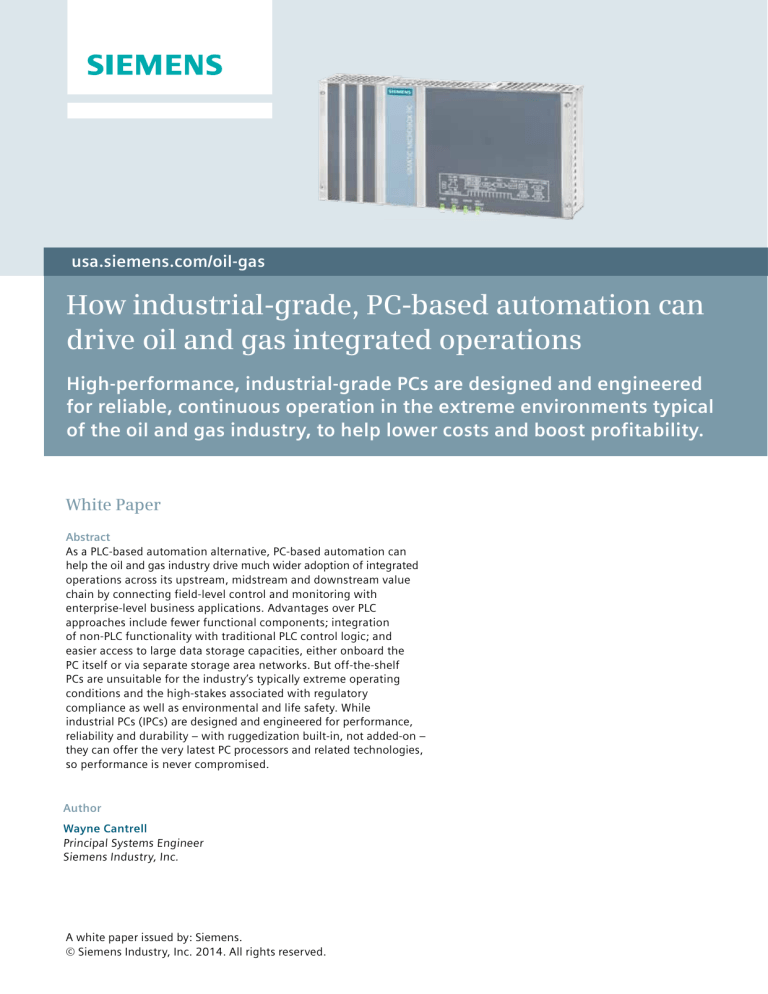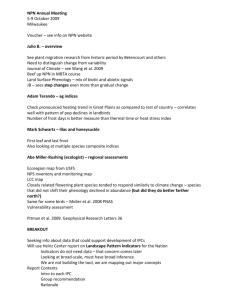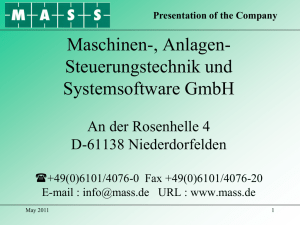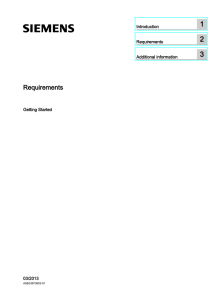How industrial-grade, PC-based automation can drive

usa.siemens.com/oil-gas
How industrial-grade, PC-based automation can drive oil and gas integrated operations
High-performance, industrial-grade PCs are designed and engineered for reliable, continuous operation in the extreme environments typical of the oil and gas industry, to help lower costs and boost profitability.
White Paper
Abstract
As a PLC-based automation alternative, PC-based automation can help the oil and gas industry drive much wider adoption of integrated operations across its upstream, midstream and downstream value chain by connecting field-level control and monitoring with enterprise-level business applications. Advantages over PLC approaches include fewer functional components; integration of non-PLC functionality with traditional PLC control logic; and easier access to large data storage capacities, either onboard the
PC itself or via separate storage area networks. But off-the-shelf
PCs are unsuitable for the industry’s typically extreme operating conditions and the high-stakes associated with regulatory compliance as well as environmental and life safety. While industrial PCs (IPCs) are designed and engineered for performance, reliability and durability – with ruggedization built-in, not added-on – they can offer the very latest PC processors and related technologies, so performance is never compromised.
Author
Wayne Cantrell
Principal Systems Engineer
Siemens Industry, Inc.
A white paper issued by: Siemens.
© Siemens Industry, Inc. 2014. All rights reserved.
White paper | Industrial-grade, PC-based automation
When just any PC won’t do…
Visit enough industrial facilities and you’re bound to eventually see it: A mission-critical process application controlled by an off-the-shelf PC that’s subject to all sorts of adverse conditions – dust, heat, vibration and possibly even Class I hazardous surroundings. Chances are, the PC is likely the same brand and model you might buy for your home or office.
Talk about a weak link. And what you see may well be operating despite the facility having perhaps millions of dollars in feeder stocks awaiting processing, many millions more in orders pending fulfillment and perhaps scores of people whose jobs depend on that production line to keep moving.
In the oil and gas industry, the stakes can be even greater, not just in terms of cost but also because they can include heavy regulatory penalties, environmental damages and, most critically, the life safety of personnel and surrounding communities. That’s all the more reason to entrust PC- based automation for oil and gas applications to specially designed and engineered industrial PCs (IPCs).
For integrated operations across the full length of the industry’s upstream, midstream and downstream value chain, IPCs can offer a number of advantages in terms of reliability, durability, real-time operations, security, data protection and specialized form factors for deployment flexibility. But
IPCs also need to withstand the industry’s extreme and hazardous operating conditions with ruggedization built-in, not added on.
What is “integrated operations”?
The term “integrated operations” refers to the real-time gathering, consolidation and analysis of data spanning the entire oil and gas value chain, from upstream production to midstream transport and downstream refining. Upstream, it can connect the data spawned by an oilfield’s entire operations, from the tip of a drill bit at the bottom of a bore hole to the flow of oil and gas out a pipeline to a refiner or consolidator. Producers can use these capabilities to make better, more informed decisions about how to optimize asset utilization, while gaining more operational visibility and information-sharing across their enterprises.
S7-1200 and S7-1500 model lines, PLCs are close to being
multi-function computers themselves. But for all that, an
IPC can perform nearly all the functions of a PLC, with
these advantages: n Fewer functional components needed for use in an
application, making a solution smaller and less expensive.
For example, an IPC can consolidate such elements as the PLC
itself, plus its HMI, normal and fail-safe controls and any
customization that might be required.
n Integration of non-PLC
functionality with
traditional PLC control
logic, while providing
process and industrial
engineers with more
opportunities to tailor their
Sample IPC Applications
Data collection and conversion
• Data recording directly at the
machine
• Interface between machine
and IT
• Link to corporate information
systems applications to specific
requirements. IPCs can
run PLC logic just as a PLC
can. An example of this in
the oil and gas industry
would be to integrate a
monitoring and control
application in a driller’s
Automation tasks
• Control and visualization with
one device
• Complex SCADA applications
• Flexible integration of PC
hardware and software
cabin with a producer’s
enterprise resource
planning (ERP) system
back at headquarters.
Industrial servers and workstations
• PC applications in production
• Machine-level server
applications
• Data management in control
rooms
capacities on-board or
connected (e.g., storage area networks) for various black-box
applications that generate large amounts of data or in order to
collect high-speed data from process applications. One SIMATIC
IPC customer application, for example, generates 400KB of
data every second – or 10.3GB per day – from an industrial,
data-gathering application.
This paper offers insights into the comparative advantages of using IPCs over PLCs for monitoring and controlling various processes in oil and gas industry applications. It uses the inner workings and features of the Siemens SIMATIC line of high- performance IPCs to illustrate what distinguishes a heavy-duty
IPC from its distant, off-the-shelf cousin. These features can also be used to compare IPCs from other manufacturers.
IPC or PLC? That is the question
Why use an IPC instead of a PLC for automation applications?
Good question. With the advancements in PLC technology and functionality over the past decade, like in the Siemens SIMATIC n Additional security mechanisms not typically provided in a
PLC or off-the-shelf PCs. For example, IPCs can use non-volatile
random-access memory (NVRAM) to retain data when power
is turned off, due to either a safety-related shutdown, power
failure or some other system fault. This is in contrast to
dynamic random-access memory (DRAM) and static random-
access memory (SRAM) typical of office-grade PCs. Both
maintain data only for as long as power is applied. Another
example is PROFIsafe, a communication protocol used by
WinAC on Siemens IPCs to ensure fail-safe operation by
adding data security and time-constrained data delivery
capabilities. PROFIsafe doesn’t correct errors, but it puts
the system into a safe state in the event of errors. Other
security mechanisms include encrypted data storage and
communications (e.g., VPN), as well as OEM licensing and
compiled control algorithms to protect the intellectual
property of application developers.
A white paper issued by: Siemens.
© Siemens Industry, Inc. 2014. All rights reserved.
White paper | Industrial-grade, PC-based automation
outdoors in desert or equatorial tropic environments, or in
refinery operations – temperatures that can cook the insides
of a standard PC. Models are available that are rated NEMA 4
and IP65 for protection against dust and water intrusion.
Other important points to note about SIMATIC IPCs include:
including rack, box and embedded IPC configurations with
separate HMIs, as well as panel IPCs with 12-,15-, 19- and
22-inch touch-screen displays. (SIMATIC industrial thin-
clients are available, too.)
What makes SIMATIC IPCs a special breed of PCs?
While readers now know the broad differences between IPCs and standard, office-grade PCs, it helps to go a bit deeper into those distinctions to understand how they can benefit oil and gas industry applications. Let’s start with the two most obvious ones that we’ve already touched on: built-in reliability and extreme ruggedness. Consider:
performance for reliability and ruggedness. Their CPUs can
range from the energy-efficient Intel® Atom™ processor for
applications with limited power sources, such as solar, or
with limited power demands, such as data collection, to more
powerful, fourth-generation Intel Celeron™, Xeon™ and Core™
i3, i5 or i7 processors. Up to 16GB of RAM can be factory-
installed or easily upgraded later.
to provide continuous operating reliability with very high
mean-time-to-failure (MTBF) rates – greater than 10 years.
To achieve such levels of availability, Siemens does main
circuit board and BIOS development in-house under its strict
quality standards.
Solid-state components are used, such as hard drives, so
SIMATIC IPCs have no moving parts. All models use their
metal frames as heat sinks for cooling, eliminating the need
for fans in some models – and further reducing possible
points of failure. In addition, all IPC solder connections are
tested via X-rays to ensure quality. IPCs endure continuous
testing on vibration tables to validate that they can with
stand the same after deployment.
n Extreme ruggedness. Thermal stress testing subjects each
assembled IPC to a 36-hour run-in test at maximum load and
104°F (40°C) ambient temperatures. This ensures that each
IPC can operate in the extreme heat for which it is rated. In
fact, two SIMATIC high-end IPC models are temperature-
rated to 134°F (55°C). These temperatures can reflect the
operating conditions of oil and gas applications, especially
To protect data, IPCs use non-volatile RAM that retains its
data if power is interrupted. This eliminates the need for
costly and bulky backup UPS power systems. RAID-1 storage
via solid-state drives (SSDs) provide additional data protection
by creating a mirrored data set. More comprehensive RAID-5
storage is available. Built-in PROFINET and PROFIBUS with their
own ports keep PCI card slots free for other functionality
and applications.
with the Microsoft Windows 7 Ultimate (32/64-bit) operating
system and a five-language, multi-lingual user interface (MUI)
to facilitate the globalization of applications. Also standard is
the Windows Embedded Standard Real-Time Operating System
(RTOS) – although Linux, QNX and Wind River VxWorks RTOSs
are available upon request. Microsoft Windows provides
compatibility with the widest number of applications in the
world, while giving oil and gas producers access to the world’s
biggest community of developers.
A white paper issued by: Siemens.
© Siemens Industry, Inc. 2014. All rights reserved.
An RTOS provides PC applications with the capability to execute
an action or process within a defined time frame, usually
milliseconds, which is considered “near-real-time.” Standard PCs
can execute PC functions like a mouse click or key stroke in
“non-real-time” at speeds between 75 and 100 ms or slower,
because that’s the threshold of human perception. In other
words, people won’t notice a mouse click or key stroke done
any faster. But industrial applications often need to execute
much faster (< 50 ms) and in deterministic, fixed-precision
timeframes, because a process requires it.
White paper | Industrial-grade, PC-based automation
to cyber security is a layered, so-called defense-in-depth
strategy. For this, SIMATIC IPCs can provide an important tier of
protection through the installation of software firewalls, VPNs
and strict user authentication policies. Antivirus software using
deep-packet inspections of network traffic can guard against
malware and alert administrators of cyber attacks.
control – especially for the sake of life-safety in hazardous
environments – SIMATIC IPCs implement the PROFIsafe safety
communications technology for distributed automation,
similar to SIMATIC safety-rated PLCs.
PROFIsafe is a way for the IPC to monitor the proper operation
of its own internal commands and detect errors as they occur.
This can avoid costly production disruptions or, worse, the
triggering of an undesirable event (like a valve release), which
could have grave environmental consequences that endanger
personnel or nearby communities. If the system detects an
error, it then shuts down safely.
PROFIsafe is designed as a separate layer on top of an IPC’s
PROFINET and PROFIBUS communications layers to reduce the
probability of data transmission errors. In effect, it provides a
“fail-safe” system that complies with the globally recognized
IEC 61508 safety standard and can be used in safety-rated
applications up to Safety Integrity Level (SIL) 3. To achieve this,
PROFIsafe uses error- and failure-detection mechanisms
such as:
• Consecutive numbering
• Timeout monitoring
• Source/destination authentication
• Cyclic redundancy checking (CRC) n
often deployed in distant oil and gas production or transmission
applications, service calls can be expensive, while disruptions
can be costly. The Intel CPUs that are the brains of every
SIMATIC IPC have Intel’s Active Management Technology (AMT)
firmware installed. This enables a remote systems administrator
with an Ethernet connection to manage – securely and via
encrypted communications – all IPCs on a network, as well
as to diagnose any problems and update BIOS and software.
With an Internet connection, administrators can literally be
anywhere in the world and yet be able to remotely restart an
IPC and access its BIOS and all applications, as if the IPC was
on their desktop. In addition, SIMATIC IPCs feature diagnostic
utilities that can assess their components’ operating conditions,
similar to how PLCs can do the same (e.g., CPU temperature,
cooling fan speeds and so forth).
Department of Homeland Security, the energy sector is the #1
target of cyber attacks of all 16 critical industries tracked by its
Industrial Control Systems Cyber Emergency Response Team
(ICS-CERT). The number of attacks can be three times those on
critical manufacturing facilities, the runner-up, and 30 times
those on government facilities. Today’s best practice approach
big advantages for the oil and gas industry is enabling more
widely integrated operations via applications that combine
PLC control logic with more enterprise-oriented PC-based
applications. But to achieve these integrations and also to
create custom applications, developers and integrators need
a wide range of tools and resources to make software
development and engineering cost-effective.
To help, the SIMATIC IPC portfolio includes an Open Developers
Kit (ODK), with even more tools for customizing applications,
integrating specialized hardware, connecting with enterprise
business systems and interacting with higher-level languages
such as Java, Visual Studio and C++. Developers can implement
their applications either in Windows or in the RTOS. Examples
include: ultra-fast algorithms used in closed-loop controllers
and sorting processes; well-head performance data acquisition
and analysis in SQL databases; and applications using the IPCs’
serial interfaces to connect peripherals, like video cameras on
offshore rigs, with centralized monitoring systems at
onshore headquarters.
* * *
Conclusion
As a capable and flexible high-performance alternative to
PLCs, PC-based automation can help the oil and gas industry adopt integrated operations more widely across the full range of its value chain to lower costs and boost profitability. But purpose-built IPCs are needed. That’s because office-grade PCs cannot withstand the rigors of general industrial environments, much less those of the oil and gas industry. While IPCs must be designed and engineered from the start with reliability and ruggedness in mind, performance does not have to be sacrificed. Siemens SIMATIC IPCs are examples of these kinds of devices, and their features can provide benchmarks to evaluate IPCs from other suppliers. To learn more about the full line of Siemens SIMATIC IPCs, readers are invited to visit: www.usa.siemens.com/IPC.
Subject to change without prior notice.
Order No.: XXXX-XXXXX-0914
Printed in USA
All rights reserved.
© 2014 Siemens Industry, Inc.
Siemens Industry, Inc.
3333 Old Milton Parkway
Alpharetta, GA 30005 usa.siemens.com/oil-gas
All trademarks used are owned by
Siemens or their respective owners.
A white paper issued by: Siemens.
© Siemens Industry, Inc. 2014. All rights reserved.




